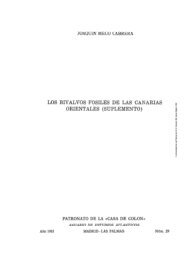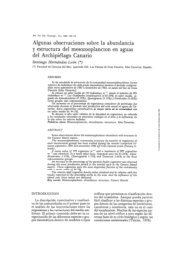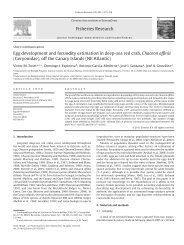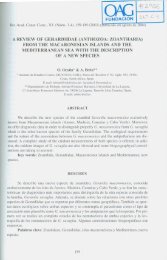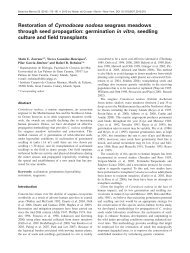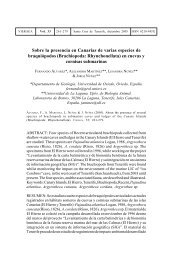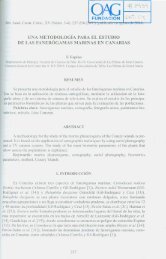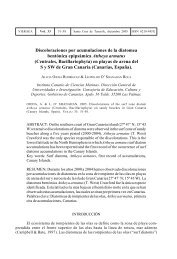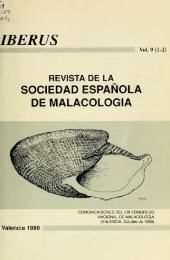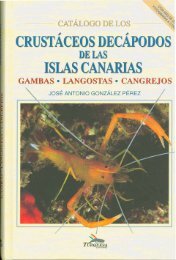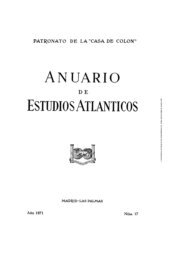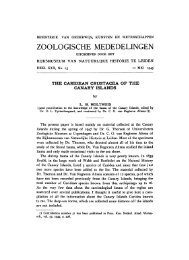of the madeira and selvagens archipelagos - redmic
of the madeira and selvagens archipelagos - redmic
of the madeira and selvagens archipelagos - redmic
Create successful ePaper yourself
Turn your PDF publications into a flip-book with our unique Google optimized e-Paper software.
1. Introdução<br />
As plantas vasculares constituem o elemento paisagístico<br />
dominante e estruturante em todos os ecossistemas<br />
terrestres. Foram aliás as densas florestas da Madeira que<br />
mais impressionaram os primeiros relatos, como o de Gaspar<br />
Frutuoso (1590) no século XVI:<br />
“Toda esta ilha é fragosissima e povoada de alto e fresco<br />
arvoredo, que, por ser tal, se perdem alguns caminhantes<br />
nos caminhos, e aconteceu já alguns, perdidos, neles morrerem.<br />
E não, tão somente, há pelo meio e lombo da terra<br />
gr<strong>and</strong>es e alevantadas serranias, mas também grotas e altas<br />
funduras, cobertas de matos e grossos paos e arvoredo de<br />
til” in Saudades da Terra.<br />
O nome da ilha é reflexo da exuberante paisagem florestal<br />
pristina, tal como refere Camões:<br />
Passamos a gr<strong>and</strong>e ilha da Madeira<br />
Que do muito arvoredo assim se chama<br />
Das que povoamos a primeira<br />
Mais célebre por nome que por fama (…)<br />
Os Lusíadas, Canto V<br />
A riqueza florística dos arquipélagos da Madeira e das<br />
Selvagens resulta da sua posição geográfica (relativa aos<br />
restantes arquipélagos atlânticos e aos continentes africano,<br />
europeu e americano), origem geológica (5,6 a 27 milhões<br />
de anos) e história climática. Estes factores condicionaram<br />
quer a colonização, quer aspectos tão importantes<br />
como a posterior radiação adaptativa e não -adaptativa das<br />
plantas vasculares em diferentes tipos de habitats resultantes<br />
de uma orografia complexa.<br />
A origem da flora dos arquipélagos da Madeira e das<br />
Selvagens tem sido alvo de amplo debate desde o século<br />
XIX, com a visita de numerosos naturalistas e com a ilha da<br />
Madeira a ser utilizada como “caso de estudo”. Muitos, senão<br />
a maioria dos autores, consideraram a flora da Madeira<br />
como reliquial (paleo -endémica), origem comprovada pelos<br />
fósseis do Terciário Médio e Final (no continente europeu),<br />
que correspondem aos géneros das principais árvores das<br />
laurissilvas da Madeira, como por exemplo Apollonias, Laurus,<br />
Ocotea e Persea. A vegetação extremamente original,<br />
endémica destas ilhas, representa os vestígios da vegetação<br />
subtropical do Terciário que terá predominado na bacia<br />
ocidental do oceano arcaico Tethys, que ligava o Atlântico<br />
e o Índico, e onde actualmente se situa o mar Mediterrâneo.<br />
As pr<strong>of</strong>undas crises ambientais (geológicas e climáticas),<br />
do final do Terciário e posteriormente do Pleistocénico (os<br />
sucessivos períodos glaciares), afectaram intensamente a<br />
vegetação continental. A flora da Madeira resulta da contemporaneidade<br />
com os processos descritos, do isolamento<br />
insular e consequente amenidade climática, factores que<br />
permitiram a sobrevivência destes elementos mais antigos<br />
(Capelo et al. 2004, 2007).<br />
Capelo et al. (2004) resumem os desenvolvimentos mais<br />
recentes sobre a história evolutiva da flora da Madeira. Num<br />
período inicial a maioria dos autores considerou como mais<br />
158<br />
1. Introduction<br />
Vascular plants are <strong>the</strong> dominant element in <strong>the</strong> composition<br />
<strong>and</strong> structure <strong>of</strong> <strong>the</strong> l<strong>and</strong>scape in most terrestrial<br />
ecosystems. The dense <strong>and</strong> luxurious forests <strong>of</strong> Madeira<br />
Isl<strong>and</strong> deeply impressed <strong>the</strong> first visitors, as attested by <strong>the</strong><br />
early writings about Madeira, like <strong>the</strong> one from Gaspar Frutuoso<br />
(1590) in <strong>the</strong> XVI century:<br />
“This isl<strong>and</strong> is mountainous <strong>and</strong> harbours tall <strong>and</strong> fresh<br />
forests, where, due to its extension, many people have lost<br />
<strong>the</strong>mselves in its pathways <strong>and</strong> several, being lost, have perished<br />
<strong>the</strong>re. And, not only thus this l<strong>and</strong> have high mountains<br />
but also deep valleys covered by vegetation with thick<br />
trees <strong>and</strong> til forests” in Saudades da Terra.<br />
The name <strong>of</strong> <strong>the</strong> isl<strong>and</strong> reflects its pristine forest l<strong>and</strong>scape,<br />
as noted by Camões in his prominent work:<br />
We passed <strong>the</strong> fine isl<strong>and</strong> <strong>of</strong> Madeira<br />
Named for its great forests, <strong>and</strong> known<br />
More for its name than its ancient past<br />
For we were <strong>the</strong> first to people it, (…)<br />
The Lusiads, trad. L<strong>and</strong>eg White, Oxford,<br />
Oxford University Press, 2002, p.99.<br />
The floristic richness <strong>of</strong> <strong>the</strong> <strong>archipelagos</strong> <strong>of</strong> Madeira <strong>and</strong><br />
Selvagens results from <strong>the</strong>ir geographic location (relative<br />
to <strong>the</strong> o<strong>the</strong>r Atlantic <strong>archipelagos</strong> <strong>and</strong> to <strong>the</strong> African, European<br />
<strong>and</strong> American continents), geological origin (5.6 to<br />
27 million years ago) <strong>and</strong> climatic history. These factors<br />
constrained <strong>the</strong> colonisation <strong>of</strong> vascular plants <strong>and</strong> o<strong>the</strong>r<br />
important processes, such as adaptive <strong>and</strong> non -adaptive<br />
radiation over different habitats resulting from <strong>the</strong> complex<br />
isl<strong>and</strong> orography.<br />
The origin <strong>of</strong> <strong>the</strong> Flora <strong>of</strong> <strong>the</strong> Madeira <strong>and</strong> Selvagens <strong>archipelagos</strong><br />
has been amply debated since <strong>the</strong> XIX century;<br />
numerous naturalists have visited <strong>the</strong> isl<strong>and</strong> <strong>and</strong> used it as<br />
a “case study”. Many, if not <strong>the</strong> majority <strong>of</strong> <strong>the</strong> authors, considered<br />
<strong>the</strong> Flora <strong>of</strong> Madeira relictual (palaeo -endemic), its<br />
origin supported by fossils from <strong>the</strong> Mid <strong>and</strong> Late Tertiary (on<br />
<strong>the</strong> European continent). This agrees with <strong>the</strong> extant genera<br />
<strong>of</strong> <strong>the</strong> main tree species <strong>of</strong> <strong>the</strong> Laurisilva <strong>of</strong> Madeira, such<br />
as Apollonias, Laurus, Ocotea <strong>and</strong> Persea. The primitive vegetation,<br />
endemic to <strong>the</strong>se isl<strong>and</strong>s, represents a relict <strong>of</strong> <strong>the</strong><br />
subtropical vegetation <strong>of</strong> <strong>the</strong> Tertiary, which prevailed in <strong>the</strong><br />
western part <strong>of</strong> <strong>the</strong> Tethys Sea Basin (a large mass <strong>of</strong> water<br />
that connected <strong>the</strong> Atlantic <strong>and</strong> Indian oceans <strong>and</strong> where<br />
<strong>the</strong> Mediterranean Sea is now located). The dramatic environmental<br />
crisis (geological <strong>and</strong> climatic), which took place<br />
in <strong>the</strong> late Tertiary <strong>and</strong> in <strong>the</strong> Pleistocene (<strong>the</strong> successive<br />
glacial periods), deeply affected <strong>the</strong> continental vegetation.<br />
The Flora <strong>of</strong> Madeira result from <strong>the</strong> contemporaneity <strong>of</strong> <strong>the</strong><br />
mentioned processes, from insular isolation <strong>and</strong> <strong>the</strong> resulting<br />
climatic amenity, factors that allowed for <strong>the</strong> survival <strong>of</strong><br />
<strong>the</strong>se older elements (Capelo et al. 2004, 2007).<br />
Capelo et al. (2004) have syn<strong>the</strong>sised <strong>the</strong> most recent<br />
developments in <strong>the</strong> evolutionary history <strong>of</strong> <strong>the</strong> Flora <strong>of</strong> Madeira.<br />
Initially, <strong>the</strong> majority <strong>of</strong> <strong>the</strong> authors considered that a



